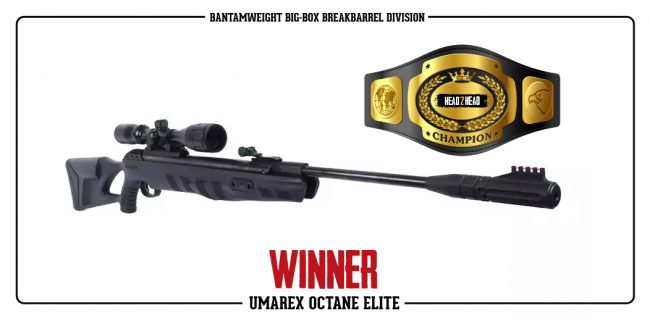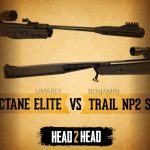With it being the heyday of the PCP rifle, sometimes it’s easy for us as airgunners to forget our roots. For many of us this hobby started off simply, with a basic multi-pump or break barrel rifle, most likely purchased from a big box store. These “big-box” rifles often come packaged in boxes plastered with claims about accuracy, quietness, or supersonic pellet speeds, but those of us in the know are all too aware that these statements are often hyperbolic in nature and don’t stack up to real world experience. However, this does not necessarily mean that big box air rifles don’t have their place. These guns are great for general airgunning, plinking and small game hunting. In today’s Head to Head we are going to look at two of the most popular options when it comes to “big box” air rifles from two of the most popular manufacturers. Let’s meet our competitors:
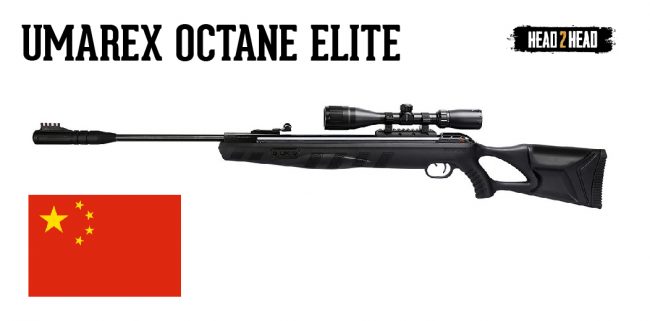
In the Red Corner is a tried and true rifle that has been updated with some new technology for 2017, weighing in at 9.5 lbs, it’s the Octane Elite from Umarex. The Octane has been one of the best selling break barrel rifles since its release and with a powerful ReAxis gas piston powerplant, a 2 stage adjustable trigger and Umarex SilenceAIR sound suppression system, it’s easy to see why the Octane has been the gateway gun for serious airgunners for some time. Umarex has added even more to the Octane Elite by adding the new StopShox recoil system that both reduces recoil and hold sensitivity but can this old favorite in new shoes hold up to the competition?
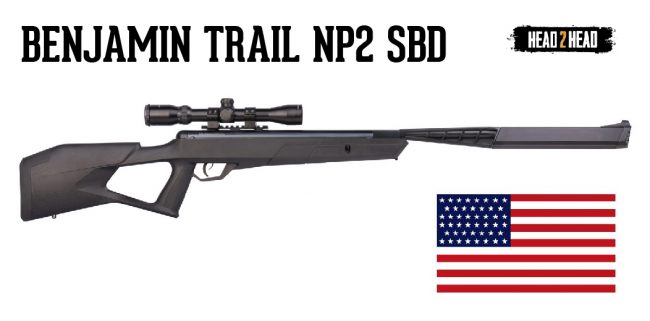
In the Blue Corner is a rifle that has probably brought more people either into or back into the sport of airgunning than any other break barrel. We are talking of course about the Benjamin Trail NP2. The Trail series has been around for some time now and has been through many iterations. Our most recent version features the new SBD ( Silencing Barrel Device), touted as being even quieter than the original NP2’s and more accurate than the competition let’s find out how these two rifles stack up.
Round 1: Ergonomics and Build Quality
Out of the box, the Octane Elite seems to be a well squared away rifle as far as ergonomics go. The forend features a large palm swell that your hand is naturally drawn to. Right away you notice the molded in texture panels that add some grippy texture to the forend. I did notice right away a bit of flex in the forend under my hand when I squeezed the gun. Bringing the gun up to my shoulder I notice two things right away. First, the pistol grip feels a bit small in my hand and has a fairly steep rake. For a guy with larger hands like myself, the thumbhole grip of the Octane may be a little on the small side to naturally settle into the rifle. The second thing that I noticed was the generous cheek pad. When brought to the shoulder my eye lined up perfectly with the scope. I pulled the scope off and when using the iron sights the cheek pad was a tad high but that can easily be compensated for. Being a lefty, one of my favorite features of most polymer stocked break barrels is that they are, typically, fully ambidextrous and the Octane is no exception. The safety catch is located in the trigger guard and is easy to actuate with either hand making this rifle a great choice for any shooter. Overall I felt that the Octane was a comfortable rifle and well thought out as far as most shooters are concerned just a bit on the small side for my 6’2” frame and bear paw hands.
The Trail NP2 is adorned in the same stock that Benjamin has been using for some time. The fit and finish of the NP2 while spartan, is is adequate. I found that the texture on both the pistol grip and the forend to be somewhat lacking compared to the Octane. There is a lot of area on the rifle that is smooth to the touch and I can imagine that on a hot or humid day that can make the rifle hard to grip while in the field. There are quite a few advantages ergonomically to the NP2 though. First being that the pistol grip has a much more vertical rake and also has a larger profile making it more comfortable in the hand. The NP2 also comes pre-equipped with sling mounts which are a nice touch if you are planning on using the NP2 for hunting. The downside though was I found the trigger guard to be somewhat small and with the addition of the safety catch being located in front of the trigger it made for a very crowded trigger guard. The NP2, like the Octane, comes with iron sights. However, the NP2 ships with the rear sight removed. Like the Octane, I’m sure that most users will go right to mounting a scope to the rifle but it would be nice if it was installed right out of the box. I’ve always been a fan of the fit and form of the NP2 rifles. They have a very modern look that is eye catching without being gaudy, considering that the design has remained pretty much unchanged for the last few years, it should feel right at home to die hard Benjamin shooters.
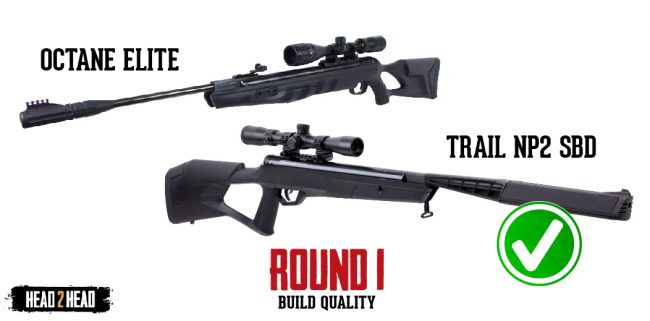
Winner: While the two are matched very similarly here, the NP2 just edges out the Octane. It’s combined positives of a more comfortable pistol grip and added sling mounts outweigh the shortcomings on the stock finish and texture where the Octane excels
Round 2: Triggers
One of my favorite features of both of these rifles is that they both have a metal trigger. This is very encouraging and I hope the days of plastic triggers in air rifles are on their way out. For this round, we simply loaded up both rifles and gave the triggers a pull using our lyman trigger gauge. Then we proceed to fire a few shots to get a good feel for the break as well as the staging of each trigger. Simple enough.
The Benjamin is a two stage and features an adjustment screw for adjusting the second stage break. The first stage is slightly spongy but not as long as other older Benjamin triggers I have pulled. The second stage break is also much improved over the older NP1 series rifles as it is much crisper, with far less creep. On our pull gauge it broke at 6 lbs 11 ounces. Certainly not the heaviest break barrel trigger I have pulled, but not the lightest either.
The Octane trigger also features a single adjustment screw, similar to the Benjamin. The first stage of the Umarex trigger is very light and short. The second stage stacks up very well and there is a definite “wall” between the first and second stage. The second stage break comes as nearly a surprise. I really found this trigger to be a joy to shoot, though it does have a good bit of overtravel after the break. On our trigger gauge the Umarex pulled at 3 lbs 13 ounces, not quite the 3.5 lbs advertised on the box, but very close.
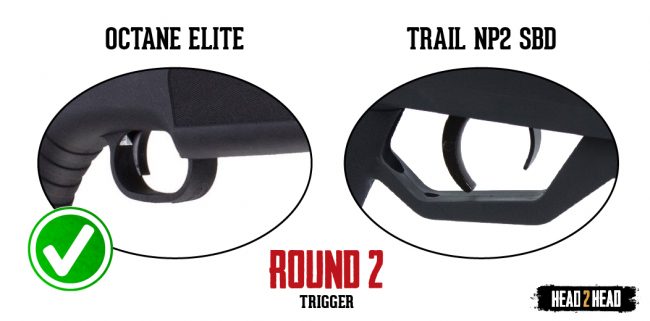
Winner: This one goes to the Umarex hands down. That trigger is probably one of the better break barrel triggers I have shot, and that’s not just compared to other big box rifles. That trigger rivals even some of the more famous triggers like those found in the TX200 or HK97 as far as out of the box shootability is concerned.
Round 3: Sound Reduction
For this test we use a simple sound meter to find out which gun is the quieter of the two. Guns are fired with the muzzle about 3 feet from the sound meter and are shot into a silent pellet trap that is about 15 yards down range. We use the same JSB Heavy pellets in each gun to avoid the possibility of sonic crack during the shots. In today’s test we did the average of 5 shots with each gun as our final sound reading.
Typically, suppressed air guns will perform very similarly and there is usually only about a 10% dB difference between the two, however, today’s results were very interesting. Both guns managed to read 65 dB on the meter for all 5 shots. Yep, these two guns performed exactly the same in the sound department. At first we thought the meter was broken but after resetting it and testing with another rifle we got nearly the same results ( the Benjamin had one shot that metered at 64 dB this time and the rest at 65). So was this test a waste as these two guns are concerned? Well not entirely.
Benjamin’s new SBD, or Silencing Barrel Device (which borrows heavily from the Silencer Co. Osprey might I add) is touted on the box as being “the quietest air rifle in its class”. While it’s not technically any quieter or louder than the competition a more appropriate tag line may be “one of the quietest air rifles in its class” or how about “as quiet as other silenced break barrels in its class”? What I’m getting at here is that silenced break barrels are nothing new at this point, and with pretty much any break barrel with a sound suppression system you are going to hear the piston or spring more than the report at the end of the muzzle. They all seem to work about the same. Okay, rant over, sorry, just had to get that out….
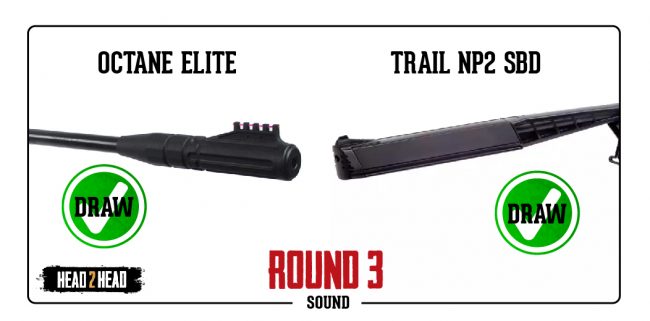
Winner: This round is a stone cold tie, both guns are quiet and both are squarely in the backyard friendly category.
Round 4: Power
For this round we fired a string of 10 shots over our Pro-Digital chronograph using Crosman 14.3 grain Premier .22 pellets. Check out the graphs below to see the shot string for each rifle:
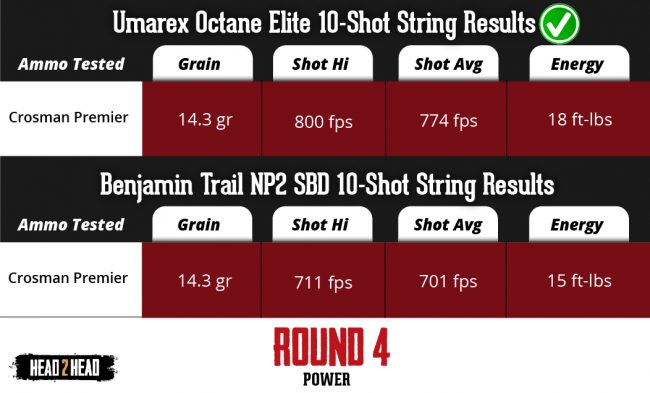
Winner: The Octane pulls this one off again! With about 70 – 80 fps more power it’s sure to put a wallop on some small game for sure!
Round 5: Accuracy
Our final test, this is what it all boils down to. We take each rifle, stretch its legs out to 50 yards and see what it can do. For this test we sighted each gun in at 25 yards and fired a variety of pellets to see what each gun likes. Then we take the best pellet from each test group and fire a 5 shot group at 50 yards and the best group wins. Pretty simple, right?
The Benjamin seemed to like the 14.3 grain Crosman Premiers that we used in our chrony tests. It fired a 1.23″ group at 25 yards, so that was our contender for the 50 yard shot. We moved our target back and got to shooting. The first 3 shots dropped about an inch low and grouped into a 1.35″ group, this gun was looking good! The next two shots flew high, like really high. I almost thought the first was a flier until the second shot landed less than an inch below it. This really opened out the group to 3.97″ at 50 yards. Not so good. I had to fire a second group just to be sure. Sure enough that group was only marginally better at 3.14″.
The Octane Elite is called the Elite because it features the new Umarex StopShox system. The StopShox system allows the rifle to recoil into the stock and basically eliminates the need for an artillery hold. Think of it like a build in artillery hold that does all the work for you. It takes all the guess work out of shooting a break barrel and makes them easy for anyone to shoot. When I first heard about StopShox I thought it was kind of a gimmick but let me tell you, it works. At 50 yards using JSB 15.39 grain pellets, the Octane Elite shot a 5 shot group of just 1.883″ with 3 of the shots stacking on each other with a nice cloverleaf pattern. That group was very impressive and It puts the Octane Elite squarely in the lead.
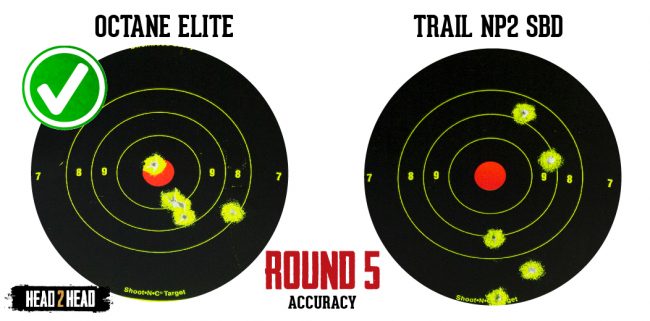
Winner: No doubt the Octane Elite stepped out on this one. It took this round easily and as such claims victory in today’s Head to Head.
